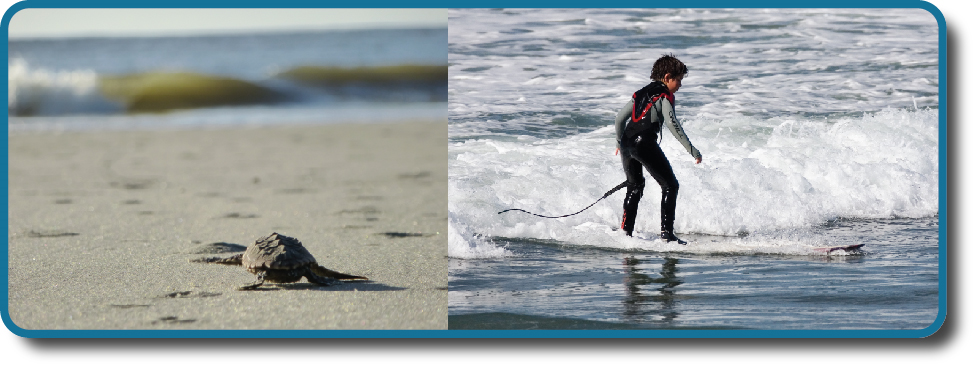6.1: مقدمة للتعلم
- Page ID
- 198340
أهداف التعلم
- لدراسة الطرق الأساسية التي يحدث بها التعلم
تشرق شمس الصيف بشكل مشرق على امتداد شاطئ مهجور. فجأة، يخرج رأس رمادي صغير من الرمال، ثم آخر وآخر. سرعان ما أصبح الشاطئ يعج بفراخ السلاحف البحرية ذات الرأس الكبير (الشكل). على الرغم من أن عمرها دقائق فقط، إلا أن الصغار يعرفون بالضبط ما يجب عليهم فعله. زعانفها ليست فعالة جدًا للتنقل عبر الرمال الساخنة، ومع ذلك تستمر في المضي قدمًا بشكل غريزي. يتم التقاط بعضها بسرعة بواسطة النوارس التي تدور فوقها ويصبح البعض الآخر غداءًا لسرطان البحر الجائع الذي يخرج من ثقوبه. على الرغم من هذه المخاطر، يتم دفع الصغار إلى ترك العش الآمن والعثور على المحيط.

ليس بعيدًا عن هذا الشاطئ نفسه، يتجول بن وابنه جوليان في المحيط على ألواح ركوب الأمواج. تقترب الموجة. يجثم جوليان على لوحه، ثم يقفز ويركب الموجة لبضع ثوان قبل أن يفقد توازنه. يخرج من الماء في الوقت المناسب لمشاهدة والده وهو يركب وجه الموجة.
على عكس السلاحف البحرية الصغيرة، التي تعرف كيفية العثور على المحيط والسباحة دون مساعدة من والديها، فإننا لا نولد ونحن نعرف كيفية السباحة (أو ركوب الأمواج). ومع ذلك، نحن البشر نفخر بقدرتنا على التعلم. في الواقع، على مدى آلاف السنين وعبر الثقافات، أنشأنا مؤسسات مكرسة بالكامل للتعلم. ولكن هل سألت نفسك يومًا كيف نتعلم بالضبط؟ ما هي العمليات الجارية عندما نتعرف على ما نعرفه؟ يركز هذا الفصل على الطرق الأساسية التي يحدث بها التعلم.
References
Anderson, C. A., & Gentile, D. A. (2008). Media violence, aggression, and public policy. In E. Borgida & S. Fiske (Eds.), Beyond common sense: Psychological science in the courtroom (p. 322). Malden, MA: Blackwell.
Bandura, A., Ross, D., & Ross, S. A. (1961). Transmission of aggression through imitation of aggressive models. Journal of Abnormal and Social Psychology, 63, 575–582.
Cangi, K., & Daly, M. (2013). The effects of token economies on the occurrence of appropriate and inappropriate behaviors by children with autism in a social skills setting. West Chester University: Journal of Undergraduate Research. Retrieved from www.wcupa.edu/UndergraduateRe...angi_S2012.pdf
Carlson, L., Holscher, C., Shipley, T., & Conroy Dalton, R. (2010). Getting lost in buildings. Current Directions in Psychological Science, 19(5), 284–289.
Cialdini, R. B. (2008). Influence: Science and practice (5th ed.). Boston, MA: Pearson Education.
Chance, P. (2009). Learning and behavior (6th ed.). Belmont, CA: Wadsworth, Cengage Learning.
DeAngelis, T. (2010). ‘Little Albert’ regains his identity. Monitor on Psychology, 41(1), 10.
Franzen, H. (2001, May 24). Gambling, like food and drugs, produces feelings of reward in the brain. Scientific American [online]. Retrieved from www.scientificamerican.com/ar...e-food-and-dru
Fryer, R. G., Jr. (2010, April). Financial incentives and student achievement: Evidence from randomized trials. National Bureau of Economic Research [NBER] Working Paper, No. 15898. Retrieved from http://www.nber.org/papers/w15898
Garcia, J., & Koelling, R. A. (1966). Relation of cue to consequence in avoidance learning. Psychonomic Science, 4, 123–124.
Garcia, J., & Rusiniak, K. W. (1980). What the nose learns from the mouth. In D. Müller-Schwarze & R. M. Silverstein (Eds.), Chemical signals: Vertebrates and aquatic invertebrates (pp. 141–156). New York, NY: Plenum Press.
Gershoff, E. T. (2002). Corporal punishment by parents and associated child behaviors and experiences: A meta-analytic and theoretical review. Psychological Bulletin, 128(4), 539–579. doi:10.1037//0033-2909.128.4.539
Gershoff, E.T., Grogan-Kaylor, A., Lansford, J. E., Chang, L., Zelli, A., Deater-Deckard, K., & Dodge, K. A. (2010). Parent discipline practices in an international sample: Associations with child behaviors and moderation by perceived normativeness. Child Development, 81(2), 487–502.
Hickock, G. (2010). The role of mirror neurons in speech and language processing. Brain and Language, 112, 1–2.
Holmes, S. (1993). Food avoidance in patients undergoing cancer chemotherapy. Support Care Cancer, 1(6), 326–330.
Hunt, M. (2007). The story of psychology. New York, NY: Doubleday.
Huston, A. C., Donnerstein, E., Fairchild, H., Feshbach, N. D., Katz, P. A., Murray, J. P., . . . Zuckerman, D. (1992). Big world, small screen: The role of television in American society. Lincoln, NE: University of Nebraska Press.
Hutton, J. L., Baracos, V. E., & Wismer, W. V. (2007). Chemosensory dysfunction is a primary factor in the evolution of declining nutritional status and quality of life with patients with advanced cancer. Journal of Pain Symptom Management, 33(2), 156–165.
Illinois Institute for Addiction Recovery. (n.d.). WTVP on gambling. Retrieved from http://www.addictionrecov.org/InTheNews/Gambling/
Jacobsen, P. B., Bovbjerg, D. H., Schwartz, M. D., Andrykowski, M. A., Futterman, A. D., Gilewski, T., . . . Redd, W. H. (1993). Formation of food aversions in cancer patients receiving repeated infusions of chemotherapy. Behaviour Research and Therapy, 31(8), 739–748.
Kirsch, SJ (2010). Media and youth: A developmental perspective. Malden MA: Wiley Blackwell.
Lefrançois, G. R. (2012). Theories of human learning: What the professors said (6th ed.). Belmont, CA: Wadsworth, Cengage Learning.
Miller, L. E., Grabell, A., Thomas, A., Bermann, E., & Graham-Bermann, S. A. (2012). The associations between community violence, television violence, intimate partner violence, parent-child aggression, and aggression in sibling relationships of a sample of preschoolers. Psychology of Violence, 2(2), 165–78. doi:10.1037/a0027254
Murrell, A., Christoff, K. & Henning, K. (2007) Characteristics of domestic violence offenders: associations with childhood exposure to violence. Journal of Family Violence, 22(7), 523-532.
Pavlov, I. P. (1927). Conditioned reflexes: An investigation of the physiological activity of the cerebral cortex (G. V. Anrep, Ed. & Trans.). London, UK: Oxford University Press.
Rizzolatti, G., Fadiga, L., Fogassi, L., & Gallese, V. (2002). From mirror neurons to imitation: Facts and speculations. In A. N. Meltzoff & W. Prinz (Eds.), The imitative mind: Development, evolution, and brain bases (pp. 247–66). Cambridge, United Kingdom: Cambridge University Press.
Rizzolatti, G., Fogassi, L., & Gallese, V. (2006, November). Mirrors in the mind. Scientific American [online], pp. 54–61.
Roy, A., Adinoff, B., Roehrich, L., Lamparski, D., Custer, R., Lorenz, V., . . . Linnoila, M. (1988). Pathological gambling: A psychobiological study. Archives of General Psychiatry, 45(4), 369–373. doi:10.1001/archpsyc.1988.01800280085011
Skinner, B. F. (1938). The behavior of organisms: An experimental analysis. New York, NY: Appleton-Century-Crofts.
Skinner, B. F. (1953). Science and human behavior. New York, NY: Macmillan.
Skinner, B. F. (1961). Cumulative record: A selection of papers. New York, NY: Appleton-Century-Crofts.
Skinner’s utopia: Panacea, or path to hell? (1971, September 20). Time [online]. Retrieved from http://www.wou.edu/~girodm/611/Skinner%27s_utopia.pdf
Skolin, I., Wahlin, Y. B., Broman, D. A., Hursti, U-K. K., Larsson, M. V., & Hernell, O. (2006). Altered food intake and taste perception in children with cancer after start of chemotherapy: Perspectives of children, parents and nurses. Supportive Care in Cancer, 14, 369–78.
Thorndike, E. L. (1911). Animal intelligence: An experimental study of the associative processes in animals. Psychological Monographs, 8.
Tolman, E. C., & Honzik, C. H. (1930). Degrees of hunger, reward, and non-reward, and maze performance in rats. University of California Publications in Psychology, 4, 241–256.
Tolman, E. C., Ritchie, B. F., & Kalish, D. (1946). Studies in spatial learning: II. Place learning versus response learning. Journal of Experimental Psychology, 36, 221–229. doi:10.1037/h0060262
Watson, J. B. & Rayner, R. (1920). Conditioned emotional reactions. Journal of Experimental Psychology, 3, 1–14.
Watson, J. B. (1919). Psychology from the standpoint of a behaviorist. Philadelphia, PA: J. B. Lippincott.
Yamamoto, S., Humle, T., & Tanaka, M. (2013). Basis for cumulative cultural evolution in chimpanzees: Social learning of a more efficient tool-use technique. PLoS ONE, 8(1): e55768. doi:10.1371/journal.pone.0055768


